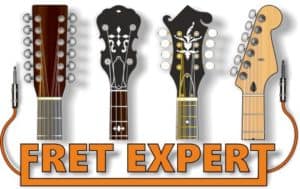The cavaquinho (cavva-keen-yo) instrument comes in two basic forms:
The Portuguese, which is about the size of a soprano ukulele, and the Brazilian, which is around the size of a concert ukulele.
Both are heavily featured in the Portuguese speaking world. A direct translation of the word cavaquinho in Portuguese means ‘little wood splinter’.
To help you tune your cavaquinho, I’ve included a set of diagrams under each of the popular tunings listed below.
These will include explanatory diagrams for the fingerboard (fretboard) layout, tuning the cavaquinho to a guitar or piano/keyboard, tuning a cavaquinho to itself by fretting at given intervals on the fingerboard, and standard staff notation.
To help get you started I’ve also included a selection of chords (graded for difficulty with a series of green dots, one being the easiest etc.) in each of the four different tunings.
Covered in this Article:
Cavaquinho Portuguese Tuning – CGAD
Two main forms of the cavaquinho are popular in Portugal, originating in different regions of the country. There’s the Lisbon (or Lisboa – leezsh-boa) from the capital, and the Minho (meen-yo) from the Minho Province in the north of the country.
Where the Portuguese instruments differ from their Brazilian cousins is mainly in the smaller size (like a soprano uke) and a fingerboard terminating at the twelfth fret.
Some models have a standard slotted headstock like a classical guitar, whereas others feature the instantly recognisable Preston cylindrical or watch-key tuners on a fan-shaped headstock.
This style of tuner is also used on the Portuguese guitar (or guitarra portugesa). The tuning isn’t totally dissimilar from the Brazilian instrument, but drops the second and fourth strings down a full tone (A instead of B and C instead of D).
Tip: If you’re beginning on your Portuguese cavaquinho journey, I’d advise you to start off with the standard slotted headstock design if you can, as tuning is a little more straightforward and less fiddly.
On the other hand, if you’re adventurous and rather fancy a conversation starter, the Preston-style tuners are sure to turn heads and raise the odd question or two.
Technique-wise, the Portuguese cavaquinho is played in a style called rasgado (has-gardo) [in English translated as ‘torn’]. This involves a rolling motion using the thumb and index finger.
Some players use other fingers to achieve the same result, but this is the most common method of strumming.
Portuguese Cavaquinho Fingerboard Layout
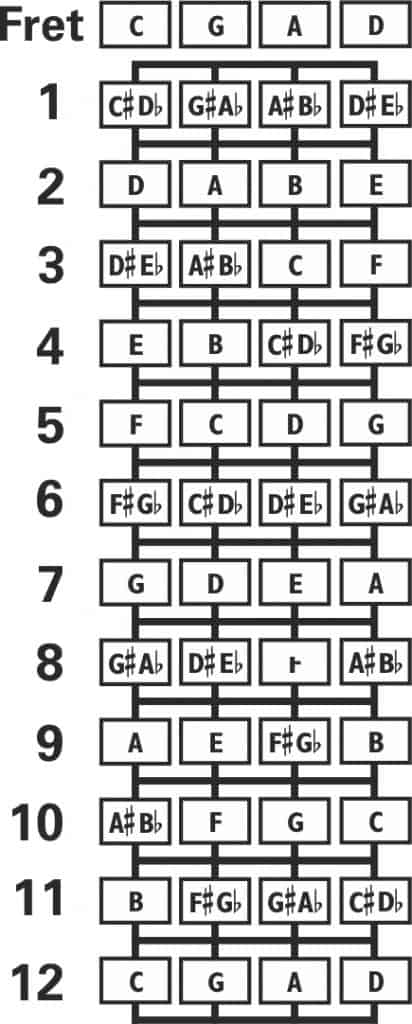
Below is a table for Portuguese cavaquinho tuning to a guitar or piano keyboard:
| Portuguese Cavaquinho | Guitar | Piano |
|---|---|---|
| 1st String (D) | 1st String (E) fretted at the 10th fret | 2nd D above middle C |
| 2nd String (A) | 1st String (E) fretted at the 5th fret | 1st A above middle C |
| 3rd String (G) | 1st String (E) fretted at the 3rd fret | 1st G above middle C |
| 4th String (C) | 2nd String (B) fretted at the 1st fret | Middle C |
And here’s how to use Portuguese cavaquinho tuning, by tuning a cavaquinho to itself:
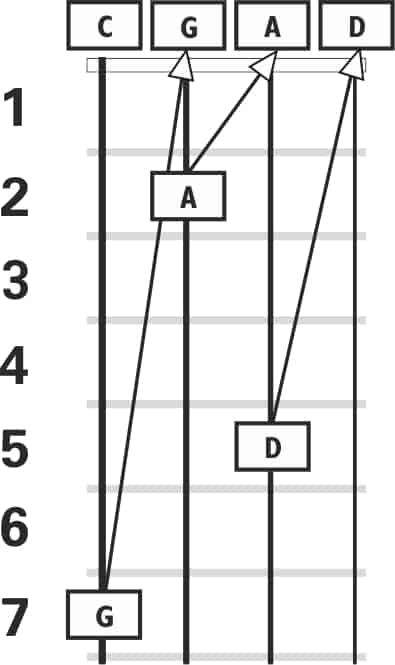
Here’s the Portuguese cavaquinho staff notation:

Cavaquinho Chords in Portuguese CGAD Tuning
Here are a selection of chords for the Portuguese cavaquinho tuning, graded by difficulty (the more green dots, the harder the chord).
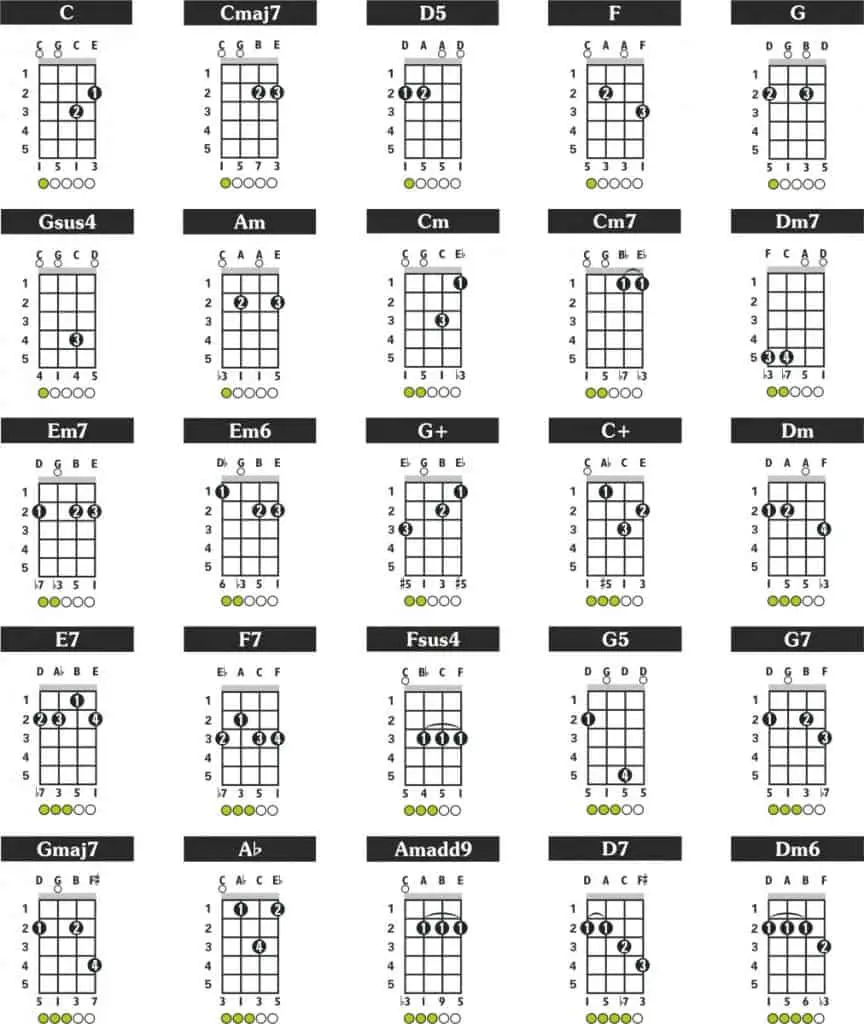
Cavaquinho Brazilian Tuning – DGBD
In Brazil, the cavaquinho is nearly always tuned to an open G major chord (DGBD), with the exception of some players who find DGBE better for playing solos. DGBE is also standard tuning for the baritone ukulele, albeit an octave lower.
A smaller version of the Brazilian cavaquinho also exists and is generally referred to as a Cavaco (cav-acko).
Both instruments are used extensively in Brazilian samba and choro music. Samba music can be traced back to West Africa via the slave trade, taking in the complex polyrhythms originating in areas of the Congo.
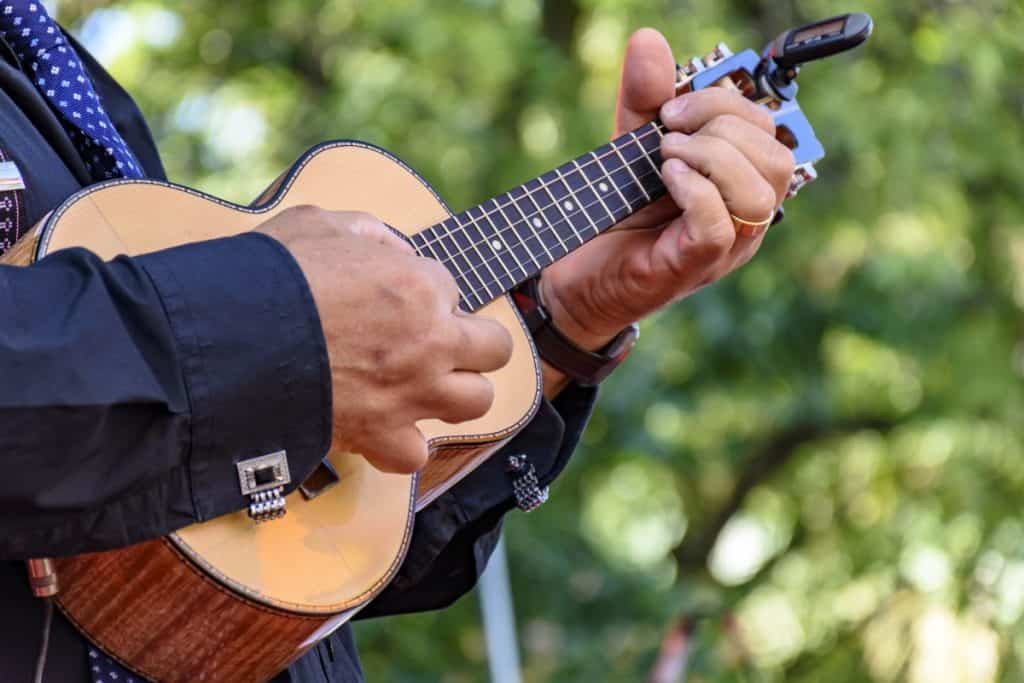
In modern times, the samba has branched off into other similar forms, including the bossa nova, which encompasses elements of jazz, popularised by composers such as Carlos Antonio ‘Tom’ Jobim, the writer of such standards as The Girl From Ipanema , One Note Samba and Desafinado.
The other popular form of music associated with the Brazilian cavaquinho, choro (shorro), typically features uptempo rhythms set against a cheerful melodic structure, relying heavily on improvisation.
The original form of choro was generally limited to a guitar, cavaquinho and flute, but gradually, over time, other instruments were introduced including the mandolin, trumpet, trombone, saxophone and clarinet.
These were supplemented by percussion including a relative of the tambourine called the pandeiro (pan-dare-ro). Within this context, the cavaquinho is used both as a melodic instrument as well as providing a chordal accompaniment.
Brazilian Cavaquinho Fingerboard Layout
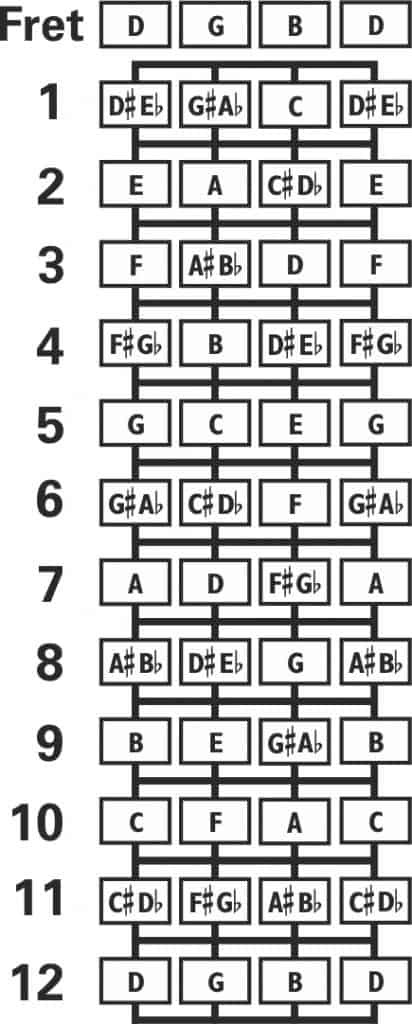
Below is a table to show how you can achieve Brazilian cavaquinho tuning using a guitar or piano keyboard:
| Brazilian Cavaquinho | Guitar | Piano |
|---|---|---|
| 1st String (D) | 1st String (E) fretted at the 10th fret | 2nd D above middle C |
| 2nd String (B) | 1st String (E) fretted at the 7th fret | 1st B above middle C |
| 3rd String (G) | 1st String (E) fretted at the 3rd fret | 1st G above middle C |
| 4th String (D) | 2nd String (B) fretted at the 3rd fret | 1st D above Middle C |
And here’s how to use Brazilian cavaquinho tuning, by tuning a cavaquinho to itself:
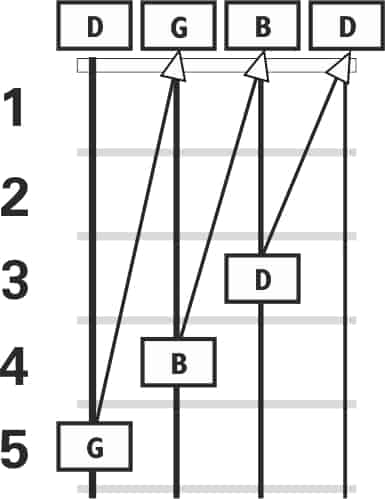
Here’s the Brazilian cavaquinho staff notation:

Chords for Cavaquinho Brazilian DGBD tuning
Here are a selection of chords for the Brazilian cavaquinho tuning, graded by difficulty (the more green dots, the harder the chord).
Tip: If you want a thorough ‘Chord Bible” for the cavaquinho in the Brazilian Tuning, then you can find my cavaquinho chordbook on Amazon here.
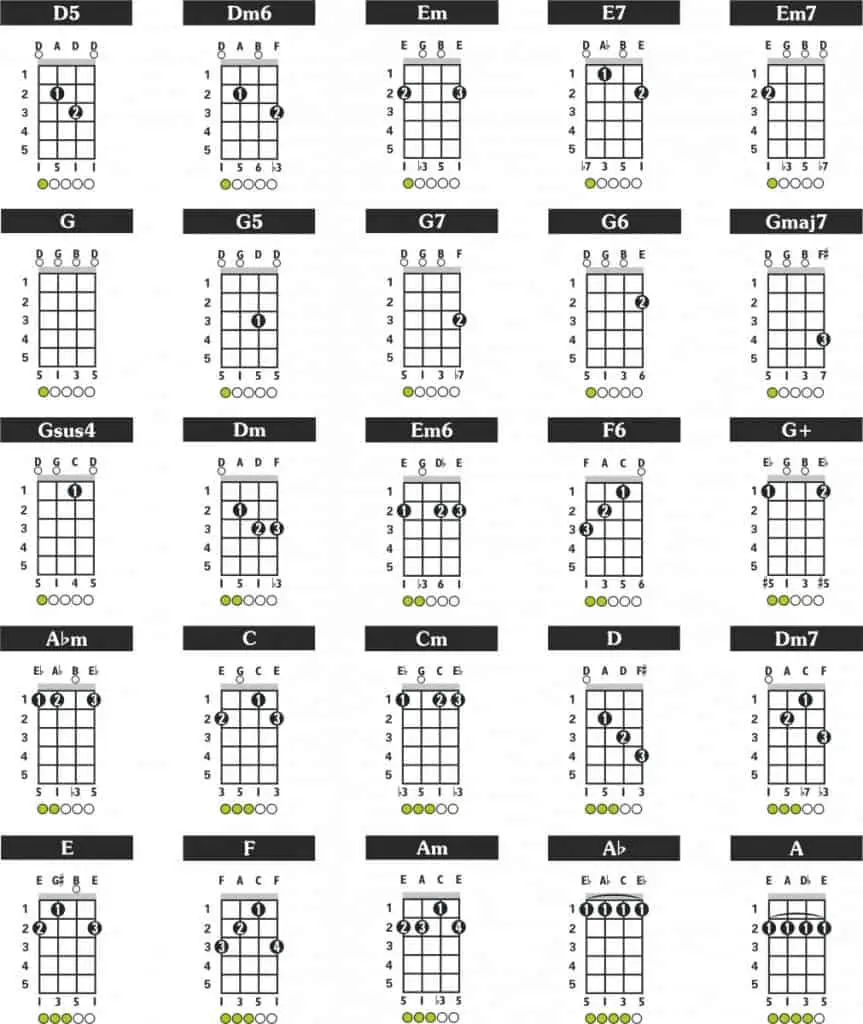
Cavaquinho Ukulele Tuning – GCEA
The cavaquinho is a close cousin of the ukulele, so perhaps unsurprisingly it is sometimes tuned like it’s Hawaiian relative.
This makes transitioning from one instrument to the other a lot less painful than it might otherwise have been.
Two uke tunings are popular in this respect, with GCEA (open C major sixth or C6) covering the standard soprano, concert and tenor ukes and DGBE (open G major sixth or G6) a direct import from baritone uke tuning (albeit an octave higher).
DGBE is also popular with Brazilian cavaquistas (cavver-key-ster) when it comes to soloing, as it slightly extends the range of the instrument by a full tone.
Cavaquinho Ukulele Tuning Fingerboard Layout
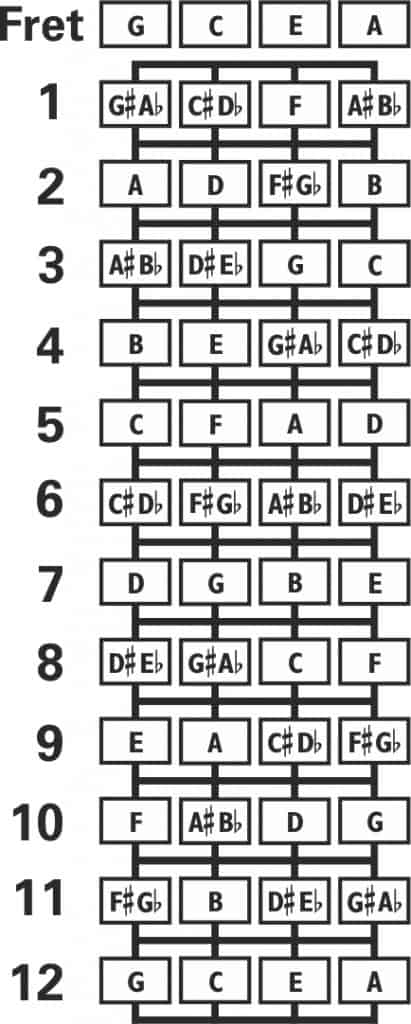
Below is a table to show how you can achieve Ukulele cavaquinho tuning using a guitar or piano keyboard:
| Ukulele Cavaquinho | Guitar | Piano |
|---|---|---|
| 1st String (A) | 1st String (E) fretted at the 5th fret | 1st A above middle C |
| 2nd String (E) | 1st open string (E) | 1st E above middle C |
| 3rd String (C) | 2nd String (B) fretted at the 1st fret | Middle C |
| 4th String (G) | 3rd open string (G) | 1st G below Middle C |
And here’s cavaquinho ukulele tuning by tuning the cavaquinho to itself:
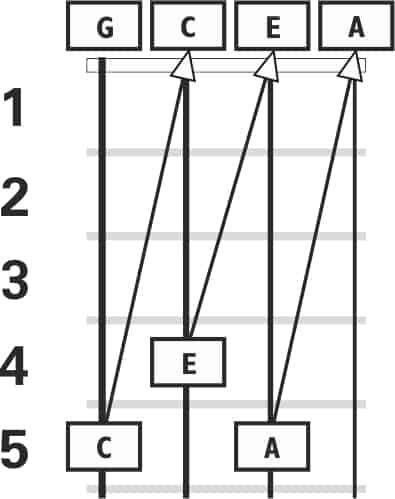
Here is the cavaquinho ukulele tuning staff notation:

Chords for Ukulele Cavaquinho Tuning
Here is a selection of chords for the Ukulele cavaquinho tuning, graded by difficulty (the more green dots, the harder the chord).
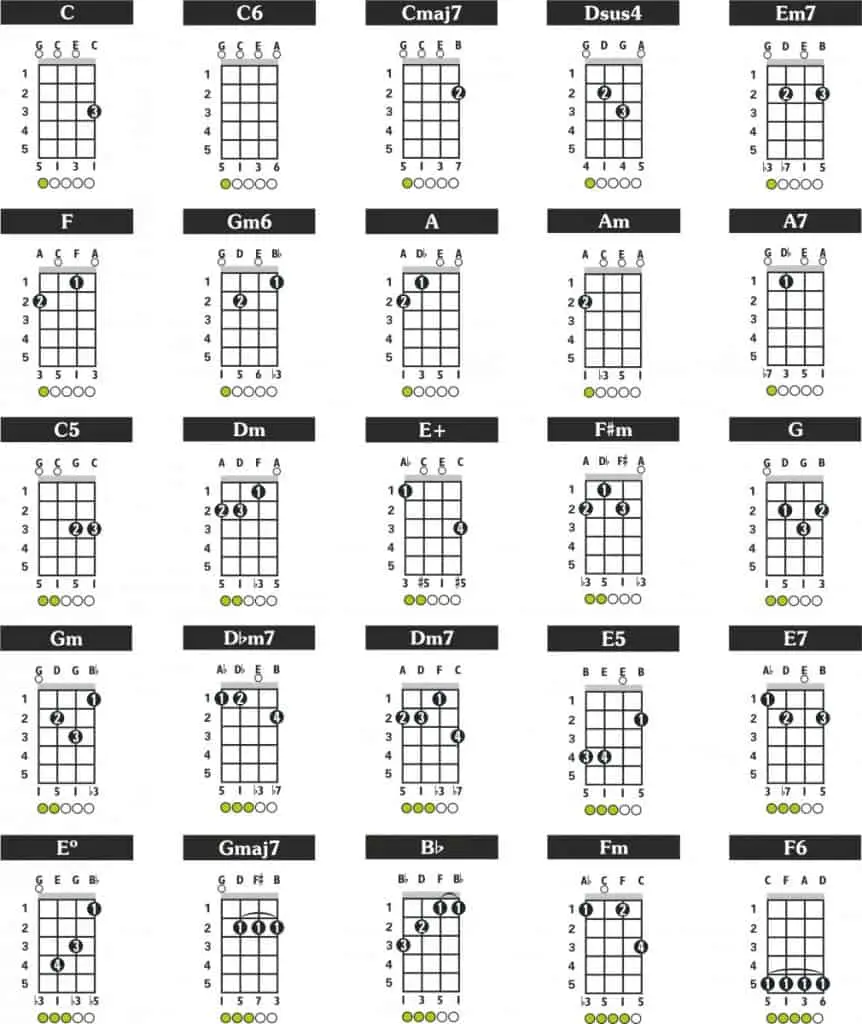
Cavaquinho Mandolin Tuning – GDAE
Because of the similarity in both size and scale length, a natural consequence was always going to be the adoption of GDAE (tuned to an A7sus4 chord) or mandolin tuning.
This is commonly done by musicians wanting to have the best of both worlds; the unmistakable ringing tone of the unison-strung mandolin and the high pitched chimes of the cavaquinho.
This makes a lot of sense, especially for mandolin players who want to transition from one instrument to the other.
Cavaquinho Mandolin Tuning Fingerboard Layout
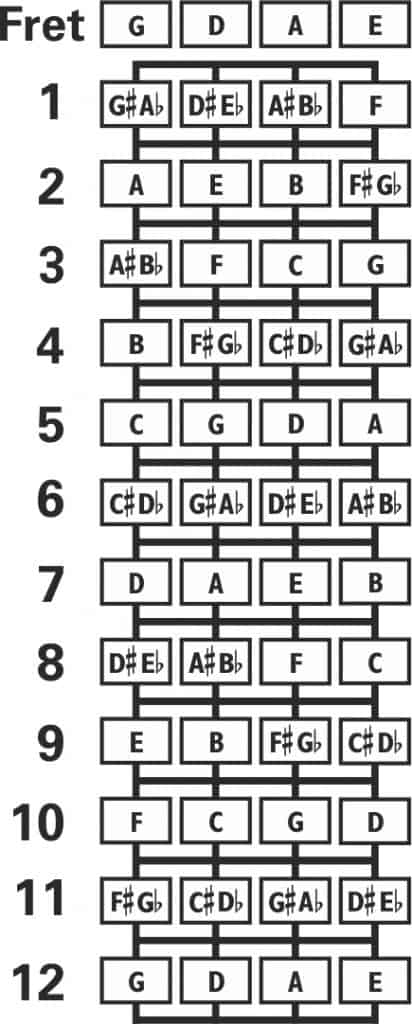
Here’s a table showing Cavaquinho mandolin tuning using a guitar or piano keyboard:
| Mandolin Cavaquinho | Guitar | Piano |
|---|---|---|
| 1st String (E) | 1st String (E) fretted at the 12th fret | 2nd E above middle C |
| 2nd String (A) | 1st string (E) fretted at the 5th fret | 1st A above middle C |
| 3rd String (D) | 2nd String (B) fretted at the 3rd fret | 1st D above middle C |
| 4th String (G) | 3rd open string (G) | 1st G below Middle C |
Here’s Cavaquinho mandolin tuning when tuning a cavaquinho to itself:
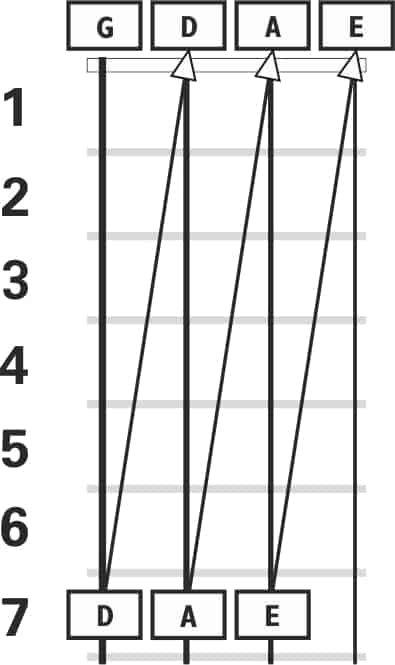
And here’s Cavaquinho mandolin tuning staff notation.

Chords for Mandolin Cavaquinho GDAE Tuning
Here are a selection of chords for the Mandolin cavaquinho tuning, graded by difficulty (the more green dots, the harder the chord).
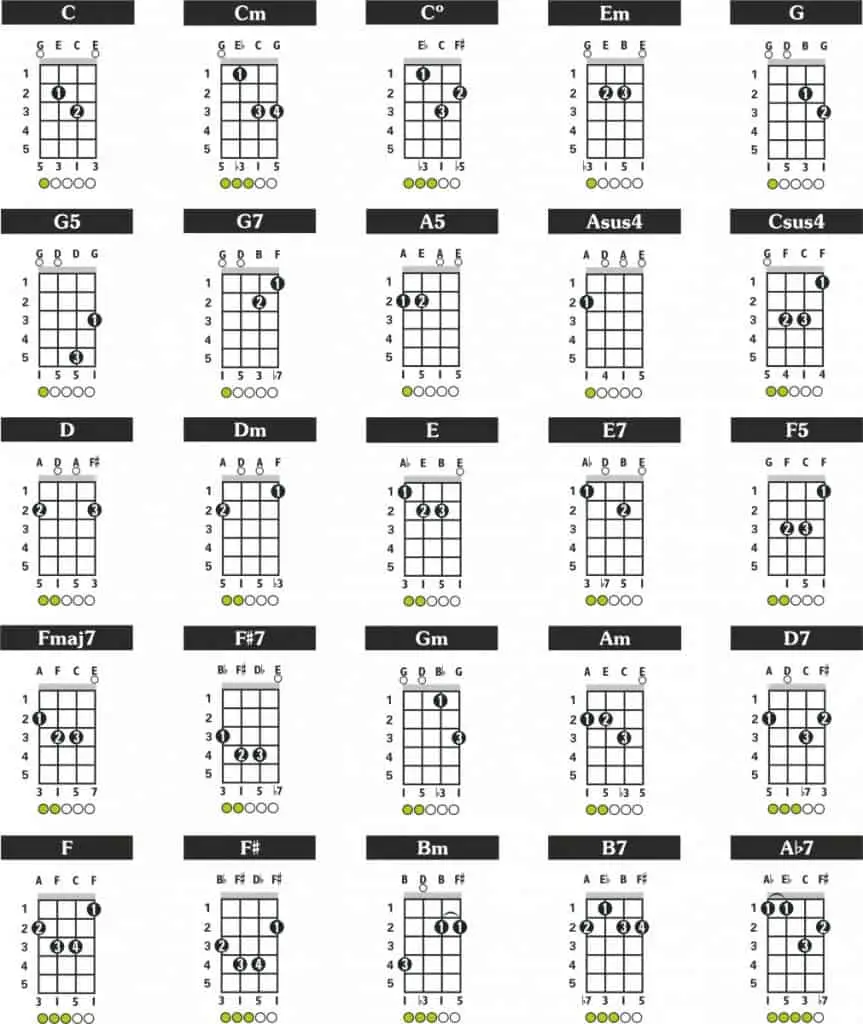
What’s the Difference Between a Ukulele and a Cavaquinho?
Physically, the cavaquinho and the ukulele are around the same size, with both featuring a four string configuration.
While the uke features nylon or composite strings, the cavaquinho is always strung with steel strings. This produces its unique timbre, which is slightly more akin to a 4-string mandolin than a ukulele.
Ukuleles are more often than not tuned using re-entrant tuning, whereas the cavaquinho tends to be tuned in a more standardized low to high configuration.
Re-entrant means the strings don’t run in a strict low to high sequence. The lowest note on the ukulele can be found on the third string, rather than the fourth – that gives the uke its unique ‘my dog has fleas’ tuning.
Whichever tuning you decide to settle upon might well depend on whether you’re coming to the cavaquinho as a brand new instrument or as a supplement to an existing instrument that you’re more familiar with.
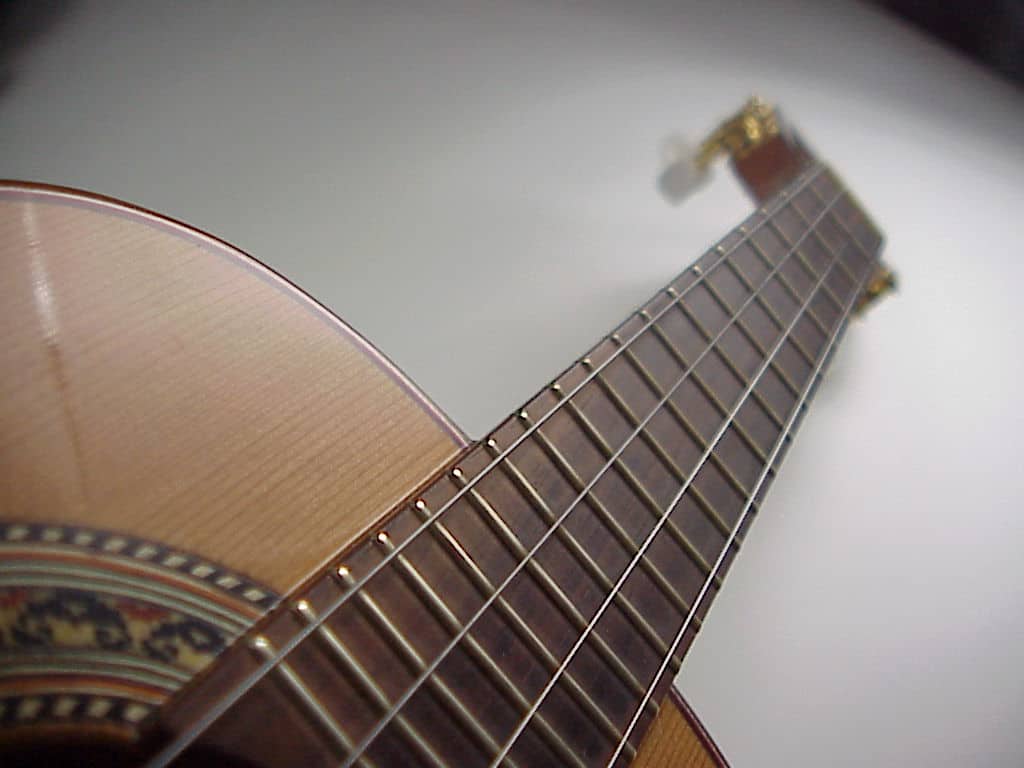
Ukulele players might understandably be reluctant to learn a different tuning and a whole new set of chords, deciding to take the line of least resisitance and stick with GCEA or DGBE, which are both fourths tunings, like the guitar.
Mandolin players may well follow suit and find that the familiar GDAE produces a sufficiently different sound to the mandolin without the hassle of again learning a totally different set of chords.
Arguably whichever tuning you decide upon, it’s still going to sound much more like a cavaquinho than a ukulele or a mandolin.
If you value tradition over convenience, then, by all means, opt for one of the top two tunings (depending upon which model you own). CGAD and DGBD are likely to be used by most cavaquistas (cavva-key-ster) playing traditional music.
Similar Instruments to the Traditional Cavaquinho
Cape Verde Cavaquinho
A Brazilian import from the 1930s. The Cape Verdean instrument retains most of the physical features and tuning of its Brazilian cousin, but within a setting of more localised musical styles including morna, mazurka and coladeira.
Cape Verde (off the coast of North West Africa) is set within the Macaronesia Ecoregion encompassing the Canary Islands, Azores, Madeira and Savage Isles. Tuning DGBD.
Pronunciation: Cape Ver-dee
Machete or Braguinha
Another small 4-stringed instrument from the Madeira island grouping near to the Portuguese coast. The tuning doesn’t follow the standard Portuguese CGAD configuration, but adheres to its Brazilian relative using DGBD (G major) instead.
It tends to be played using an adapted rasgado technique utilizing all the fingers, minus the thumb.
Pronunciation: Mash-etti / Brag-gheen-ya
Rajão
Another Madeiran folk instrument, but featuring an additional fifth string. The rajão, like the others in this grouping uses steel strings and like the ukulele, features re-entrant tuning, with the third (lowest sounding string) or middle string tuned to a middle C.
The tuning is DGCEA, much akin to the ukulele, but with an additional fifth D string. There’s also a six string version with an extra A in the high end (DGCEAA). It’s also been called the taro-patch fiddle.
Pronunciation: hazsh-ow
Venezuelan Cuatro or Cuatro Venezolano
The 4-stringed cuatro, not to be confused with the Puerto Rican cuatro (a totally different type of instrument), is more akin to the ukulele than the cavaquinho.
It’s about the size of a baritone uke and like its close cousin, uses nylon or composite strings. Unusually, the tuning doesn’t conform to the baritone’s DGBE, but instead utilizes the original soprano tuning of ADF#B (before GCEA became standardized within the ukulele community).
Pronunciation: Kwatro (with a rolled ‘r’)
Ukulele
Undoubtedly the most well-known member of this family group, the Hawaiian uke’s design can be traced back to its close relative the machete, which was brought to the Hawaiian Islands (formerly known as the Sandwich Islands) in the 19th century.
Ukuleles are so popular now, that I’ve written several separate articles about them on this site.
